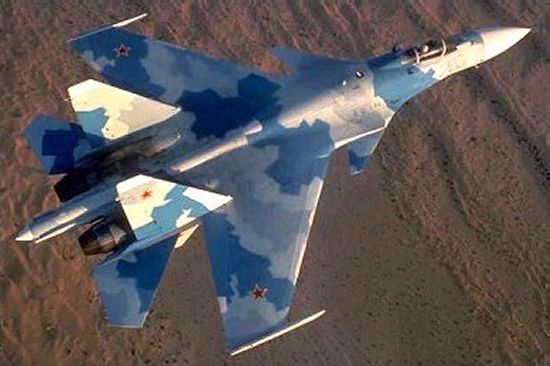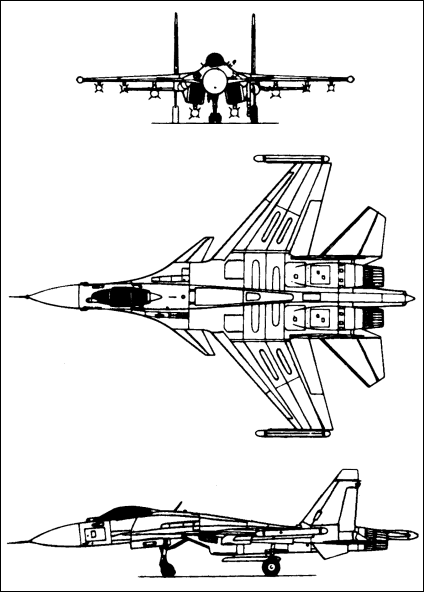|
||||||||||
|
|
||||||||||
|
||||||||||
|
|
||||||||||
 - -
 - -
|
|

|
Sukhoi Su-35 ASCC codename: Flanker Multi-Role Fighter |
|
DESCRIPTION:
The original Su-35 was a derivative of the Su-27 and essentially a ground-based variant of the Su-33. While the official Russian Air Force designation for the aircraft remained the Su-27M, Sukhoi rechristened the model as the Su-35 in the hopes of attracting foreign customers. The Su-35 design was largely identical to the Su-27 but incorporated the canards of the Su-33 and more powerful engines plus a new digital fly-by-wire control system. The Su-35 was also equipped with a new multi-mode radar, infrared detectors, and upgraded weapons. The Su-35 development program experienced many delays due to the collapse of the Soviet economy, and the Russian military ultimately chose not to purchase any. Sukhoi instead used the eleven prototypes as technology demonstrators to interest the export market in funding a production model. The most likely chance for success appeared to be Brazil's strong interest in co-producing the Su-35 that lasted for several years. Brazil required a replacement for its aging Mirage III fighters, and the Su-35 was considered the front-runner over the competing Mirage 2000, Gripen, and F-16. The Su-35 deal came close to being finalized in November 2004, but Brazil declined to sign over cost concerns. Russia later offered second-hand Su-27 aircraft as a cheaper alternative to the new-build Su-35, but Brazil opted to purchase twelve refurbished Mirage 2000 fighters from France instead. The Brazilian decision appeared to have ended the Su-35 program once and for all since Sukhoi had little success finding other customers. Hopes were briefly revived in May 2006 when Venezuela announced interest in the Su-35, but the nation instead chose a variant of the Su-30. However, the Su-35 was revived, at least in name, in 2007 when Sukhoi announced the aircraft had entered production for the Russian Air Force. This incarnation is also a derivative of the Su-27 but is not directly related to the earlier Su-27M/Su-35 prototypes. The new Su-35, called the Su-35BM by Sukhoi, is instead an upgraded variant of the Su-30. This variant is most similar to the Su-30MKI model built for India and features a more powerful engine, an improved 2D thrust vectoring nozzle, and larger air intakes. The Su-35BM lacks the canards of the original Su-35 prototypes, although some sources indicate these can be fitted at customer request. Other upgrades include an improved radar, glass cockpit displays, compatibility with additional weapons, structural strengthening to increase service life, and incorporation of newer electronics. A production model known as the Su-35S has entered acceptance testing, and 48 have been ordered by the Russian Air Force. An Su-35K export model has also been marketed to Algeria, Libya, China, India, Malaysia, and Brazil. Venezuela has placed an order for 24.
Last modified 08 May 2011
|
|
| HISTORY: | |
| First Flight |
(T-10-24) May 1985 (T-10S-70) 28 June 1988 (Su-35BM) 18 February 2008 |
|
Service Entry
|
(Su-35S) planned for 2011?
|
| CREW: |
one: pilot
|
|
ESTIMATED COST:
|
unknown
|
| AIRFOIL SECTIONS: | |
| Wing Root | unknown |
|
Wing Tip
|
unknown
|
| DIMENSIONS: | |
| Length | 72.83 ft (22.22 m) |
| Wingspan | 48.17 ft (14.70 m) |
| Height | 21.08 ft (6.43 m) |
| Wing Area | 666 ft² (62.0 m²) |
|
Canard Area
|
unknown
|
| WEIGHTS: | |
| Empty | 40,565 lb (18,400 kg) |
| Normal Takeoff | 56,660 lb (25,700 kg) |
| Max Takeoff | 74,955 lb (34,000 kg) |
| Fuel Capacity | 29,540 lb (13,400 kg) |
|
Max Payload
|
17,640 lb (8,000 kg)
|
| PROPULSION: | |
| Powerplant |
(Su-35) two Saturn/Lyul'ka AL-31F afterburning turbofans (Su-35BM) two Saturn/Lyul'ka AL-41FA afterburning turbofans with 2D thrust vector control |
| Thrust |
(Su-35) 61,730 lb (274.6 kN) (Su-35BM) 66,090 lb (294 kN) |
| PERFORMANCE: | |
| Max Level Speed |
at altitude: 1,555 mph (2,500 km/h) at 32,780 ft (10,000 m), Mach 2.3 at sea level: 895 mph (1,435 km/h), Mach 1.18 cruise speed: 870 mph (1,400 km/h) at 32,780 ft (10,000 m) |
| Initial Climb Rate | 45,235 ft (13,800 m) / min |
| Service Ceiling | 59,055 ft (18,000 m) |
| Range |
typical: 1,730 nm (3,200 km) ferry: 3,505 nm (6,500 km) |
| g-Limits |
+10
|
| ARMAMENT: | |
| Gun | one 30-mm GSh-301 cannon (149 rds) |
| Stations | twelve external hardpoints and two wingtip rails |
| Air-to-Air Missile | R-40/AA-6 Acrid, R-60/AA-8 Aphid, R-27/AA-10 Alamo, R-73/AA-11 Archer, R-77/AA-12 |
| Air-to-Surface Missile | Kh-25ML/AS-10 Karen, Kh-25MP/AS-12 Kegler, Kh-59/AS-13 Kingbolt, Kh-29/AS-14 Kedge, Kh-55/AS-15 Kent, Kh-15P/AS-16 Kickback, Kh-31/AS-17 Krypton |
| Bomb | FAB-100/250/500/750/1000, KAB-250, KAB-500L, KAB-1500 |
| Other |
rocket pods, ECM pods
|
| KNOWN VARIANTS: | |
| T-10-24 | Experimental Su-27 prototype with canards |
| T-10S-70 | Prototype |
| Su-27M 'Flanker-E' | Official Russian Air Force designation for the original Su-35 model |
| Su-35 'Flanker-E' | Production model with a new radar, improved fire-control system, glass cockpit featuring multi-function displays, and redesigned fly-by-wire system; 11 prototypes built |
| Su-35BM | Prototype of a production Su-35 based on the Su-30MKI with improved engines and thrust vectoring nozzles, larger air intakes, larger flaperons, a more powerful radar, an improved electronic warfare system, upgraded fly-by-wire control system, better glass cockpit displays, and incorporating more titanium into the airframe to increase service life to 6,000 flight hours |
| Su-35S | Serial production variant of the Su-35BM; 11 delivered by 2011 out of 48 ordered by the Russian Air Force |
| Su-27SM2 | Official designation for the Su-35BM/Su-35S in the Russian Air Force |
| Su-35K |
Export version of the Su-35S; 24 to be built for Venezuela
|
| KNOWN COMBAT RECORD: |
none
|
| KNOWN OPERATORS: |
Russia, Voyenno Vozdushniye Sili (Russian Air Force) Venezuela, Fuerza Aérea Venezolana (Venezuelan Air Force) |
|
3-VIEW SCHEMATIC:

|
|
SOURCES:
|
|


|
Aircraft | Design | Ask Us | Shop | Search |

|
|
| About Us | Contact Us | Copyright © 1997-2023 | |||
|
|
|||